The Great Freshet of 1841
The Day That Changed the Croton River Forever
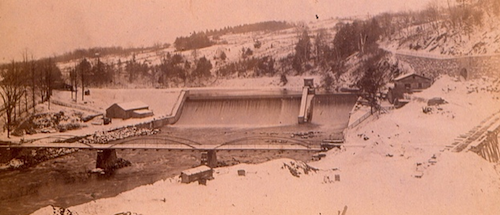 The Croton Dam in winter.
The Croton Dam in winter.
In early January, 1841 there were 18 inches of snow on the ground in the Croton area and record cold temperatures, but on January 5th, things began to change. Temperatures rose rapidly and heavy rain began to fall. By the night of the 7th, melting snow and three days of rain had swelled Westchester’s rivers and streams to bursting.
Throughout the Croton River valley people began to prepare for flooding. Workers at Bailey’s Wire Mill, at the confluence of the Croton River and Hunter Brook, hurriedly built levees to protect their property from the rising water.
Several miles upriver, near Pine’s Bridge, water and debris was piling up behind the unfinished Croton Dam, including Pine’s Bridge itself, which had been torn from its footings and had floated down the river, along with several smaller bridges, buildings, trees and large chunks of ice.
At about two in the morning on the 8th the water rose so high that it started to spill over the earthen embankment that formed part of the dam. Within an hour, the embankment started to give way, releasing a huge torrent of water, ice and debris, sweeping away everything on the river. When it roared through the narrow Croton River Gorge it rose to a height of 50 feet, before gushing out into the Hudson, silting out the mouth of the Croton River with mud and rocks.
Here is the news report of that terrible day, as reported in the Hudson River Chronicle, published in Sing Sing, on Tuesday, January 12, 1841.
The rains which commenced in this section of the country on Tuesday of last week continued with but little intermission until Thursday night last. At the time the storm commenced the snow lay upon the earth to the depth of eighteen inches. The melting of this large body of snow, together with the heavy rains, produced the largest freshet that has been witnessed in this part of the country for very many years.
All the bridges below the dam were carried away, and above the dam Pine’s Bridge, and we are informed Wood’s Bridge also, leaving no bridge over the Croton from its mouth to Golden’s Bridge.
The swelling of the Croton by the numerous streams running into it from the surrounding country became so great that fears began to be entertained on the evening of Thursday that the dam across it for the Croton Aqueduct would not withstand the pressure of the accumulated waters. That part of the dam over which it was designed the surplus waters should flow was constructed of solid masonry. Beyond this on the left bank of the river as you ascend it an embankment of earth, with a protection wall of massive stones, was constructed rising twelve feet above the tumble, as it is called (the space left for the surplus waters to pass off over the mason-work) leaving a passage for the surplus water of ninety feet in width by twelve in height. It was calculated that an opening of such dimensions would be more than sufficient to carry off the waters of the Croton when swelled to a much greater magnitude than they had ever been known to reach. But during the latter part of the freshet of last week the water above the dam, covering a space of about 600 acres, continued to rise at the rate of about one foot an hour, until it reached the astonishing height of seventeen feet above the tumble or fall of the dam and running over the top of the embankment of earth and protection wall to the depth of five feet. The design of the dam was that the water should never reach the top of this embankment, which was raised twelve feet above the tumble, or that part of the dam over which it was designed the water should flow; and when the water reached the height above mentioned, it was at once seen that the embankment must soon give way. But notwithstanding this immense pressure and rushing of water over the embankment it stood for several hours, during which every effort was made to save it by raising a dike on the top of it to a height of three or four feet during the storm. But it was discovered about one or two o’clock on Friday morning that it must soon give way, and messengers were immediately dispatched from the dam to warn the people living below, on the banks of the Croton of their danger.
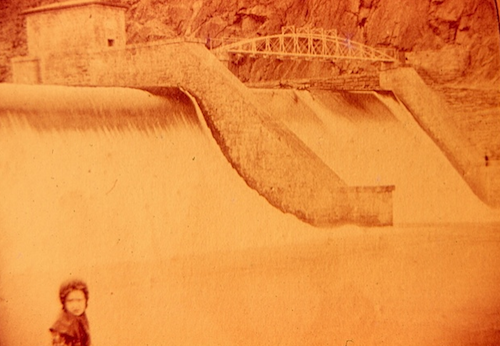 View from below the dam.
View from below the dam.As was apprehended, about four o’clock on Friday morning the embankment gave way, and the Croton below, the dam already swelled to an unprecedented height, immediately rose by means of the mighty rush of waters from above the dam, ten to fifteen feet higher, and rushed down its course with resistless force. It first encountered the mills and dwelling-house of Mr. Solomon Tompkins, which it swept away almost in a moment, and Mr. Tompkins, an aged and infirm man, had barely time to escape with the assistance of his family from his house. Passing on, and tearing up in its course earth, stones, and trees, it next reached the extensive rolling-mills and wire factory of the Messrs. Bailey situated on the banks of the Croton, which it instantly carried away, together with their dwelling-houses tenant-houses, etc.—making altogether twelve buildings—and all their machinery, stock, furniture, goods, etc. This was an extensive establishment and employed about fifty men and was situated about two miles from the dam. They were busily engaged in endeavoring to preserve their property from destruction by the water before the dam gave way.
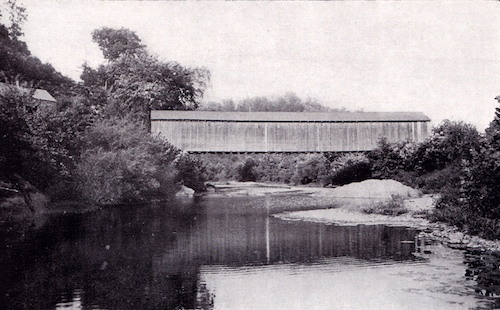 This 1902 photo shows the Wire Mill Bridge that was built to replace the one lost in the flood. This carried traffic from the “dugway”—an old road that cut across Mt. Airy—across the Croton River at Hunter Brook. The entire area is now underwater, said to be the deepest part of the reservoir.While thus engaged they heard the roaring of the waters as they came rushing down, and fled instantly for the higher grounds in the neighborhood; but so rapid was the approach of the water that some ten or fifteen individuals were overtaken and, to save themselves, were obliged to ascend the surrounding trees for safety. Among them were Mr. Joseph Bailey, Mrs. Mitchell, and a number of women with infant children. In this situation they were obliged to remain for about two hours, until the water in some measure subsided, when they were taken off with the exception of William Evans and Robert Smith, who overtaken in their flight, were obliged to ascend a cedar of smaller size, which was borne down by the water, ice, and floating timber into the current, and they were carried away amid their unavailing cries for assistance. Their bodies have not yet been found. From this place the accumulated waters dashed furiously onward along the valley of the Croton to its mouth, a distance of about three miles, carrying away in its course Quaker Bridge, Holman’s mills, and the old piers of the old Croton Bridge, and fences, timber, portions of orchards, soil, and roads along the banks of the Croton. The damage sustained by the landowners below the dam is variously estimated at from one to two hundred thousand dollars. Among the sufferers are the Messrs. Bailey, Solomon Tompkins, the owners of the Van Courtlandt estate, and Mr. Talbot.
This 1902 photo shows the Wire Mill Bridge that was built to replace the one lost in the flood. This carried traffic from the “dugway”—an old road that cut across Mt. Airy—across the Croton River at Hunter Brook. The entire area is now underwater, said to be the deepest part of the reservoir.While thus engaged they heard the roaring of the waters as they came rushing down, and fled instantly for the higher grounds in the neighborhood; but so rapid was the approach of the water that some ten or fifteen individuals were overtaken and, to save themselves, were obliged to ascend the surrounding trees for safety. Among them were Mr. Joseph Bailey, Mrs. Mitchell, and a number of women with infant children. In this situation they were obliged to remain for about two hours, until the water in some measure subsided, when they were taken off with the exception of William Evans and Robert Smith, who overtaken in their flight, were obliged to ascend a cedar of smaller size, which was borne down by the water, ice, and floating timber into the current, and they were carried away amid their unavailing cries for assistance. Their bodies have not yet been found. From this place the accumulated waters dashed furiously onward along the valley of the Croton to its mouth, a distance of about three miles, carrying away in its course Quaker Bridge, Holman’s mills, and the old piers of the old Croton Bridge, and fences, timber, portions of orchards, soil, and roads along the banks of the Croton. The damage sustained by the landowners below the dam is variously estimated at from one to two hundred thousand dollars. Among the sufferers are the Messrs. Bailey, Solomon Tompkins, the owners of the Van Courtlandt estate, and Mr. Talbot.
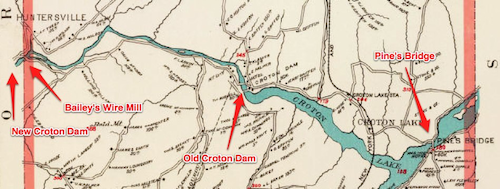 Map of the Croton Dam area in 1892. Location of the New Croton Dam is for reference.
Map of the Croton Dam area in 1892. Location of the New Croton Dam is for reference. All the bridges below the dam were carried away, and above the dam Pine’s Bridge, and we are informed Wood’s Bridge also, leaving no bridge over the Croton from its mouth to Golden’s Bridge, a distance of twelve to sixteen miles. This we were apprehensive would be productive of very great inconvenience and loss to the community; but we are happy to learn that the Water Commissioners, with a promptitude that reflects credit upon them, have already commenced laying a new bridge upon the abutments and piers of the old Pine’s Bridge, which remain uninjured, so that the bridge will probably be ready for travel in ten or twelve days.
The … waters dashed furiously onward along the valley of the Croton to its mouth … carrying away … Quaker Bridge, Holman’s mills, and the old piers of the old Croton Bridge.
We are informed that the damage done to the dam is much less than was at first supposed, the mason-work, the most expensive part of it, being but slightly injured, and that the total damage to the dam will not much exceed $40,000.
A number of individuals above the dam have suffered much inconvenience and loss by the rapid rise of the waters of the reservoir. Doctor Gedney, we understand, was driven from the principal story of his house in which the water rose to the depth of six or eight feet to the second story, when his situation was somewhat dangerous, until the dam gave way, when the water settled off so rapidly that his dwelling was entirely freed from it in a few minutes.
It is fortunate that this disaster has been attended with no greater loss of life. But one individual in addition to the two mentioned above lost his life, and he was a laborer at the dam of the name of Michael Burke, who was in a shanty below the dam and was carried off in the flood; his body was found on Saturday last, three miles below the dam, much bruised and his clothing nearly all torn off.
We learn that much damage has been done by the freshet in different parts of the country to roads, bridges, etc., the particulars of which we will lay before our readers next week
The following ad appeared in the Hudson River Chronicle, Tuesday, January 19, 1841:
Croton, January 11, 1841.
The undersigned return their sincere thanks to their neighbors for the very liberal aid extended to them and their families after the late destruction of their works by the bursting of the Croton Dam, and they would particularly acknowledge the kindness and attention of the Messrs. Henry Lounsbury, Robert Tompkins, Gabriel Purdy, Elias Purdy, William Ryder, Thomas Rowlee, and William Purdy, for the prompt and efficient aid afforded them.
JAMES BAILEY, Sr.
JOHN BAILEY
ABRAM BAILEY
JAMES BAILEY, Jr.
JOSEPH BAILEY
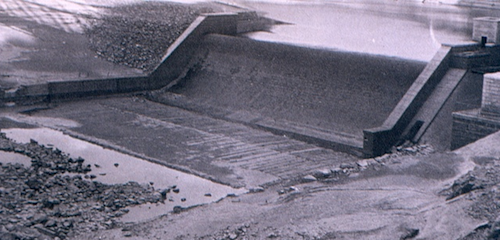 After the 1841 disaster the dam was redesigned to prevent another collapse. The earthen embankment was much stronger and the main section was given an innovative s-curve profile. The new design worked and the dam held up until it was replaced and covered by water when the New Croton Dam was completed in 1908.
After the 1841 disaster the dam was redesigned to prevent another collapse. The earthen embankment was much stronger and the main section was given an innovative s-curve profile. The new design worked and the dam held up until it was replaced and covered by water when the New Croton Dam was completed in 1908.
